Taking wedding photos is an art that captures a couple’s most cherished moments. This comprehensive guide from dfphoto.net provides insights into the world of wedding photography, covering everything from preparation to execution. It’s your roadmap to crafting timeless memories through stunning imagery, covering creative portraiture and event photography with a professional touch.
1. The Day Before the Wedding: Preparation is Key
What steps should I take the day before a wedding shoot to ensure I’m prepared?
The day before a wedding shoot is all about preparation and organization. Texting the bride to confirm your excitement and availability sets a positive tone. Gather your gear, ensuring all camera and flash batteries are charging, lenses are clean, and memory cards are clear. Double-check the schedule, refresh your memory of the locations, and confirm travel times using GPS. According to insights shared by professional wedding photographers at dfphoto.net, arriving five minutes early can set the stage for a smooth and successful day. Finally, ensure your vehicle has sufficient fuel to avoid unnecessary stress on the big day.
2. Morning of the Wedding: Fueling Up and Final Checks
What is the best routine for the morning of a wedding shoot to stay energized and organized?
The morning of the wedding should start with a hearty breakfast to keep you energized throughout the day. Pack food and drinks to graze on while traveling between locations to maintain your energy levels. Ensure your gear is packed and in the car, double-checking that batteries and cards are in your camera bag. Dress professionally, representing yourself and your brand in a way that aligns with the wedding’s formality. Finally, confirm you have all necessary paperwork, such as contracts or shot lists, preferably using a cloud-based studio management system like Tave.
3. Groom Coverage (45 Minutes – 1 Hour): Building Rapport and Capturing Details
How do I effectively cover the groom’s preparation, capturing both candid and posed moments?
Groom coverage involves building rapport with the groom, his family, and the bridal party to create a comfortable atmosphere. Start with detail shots of items like rings and cufflinks while the groom and groomsmen are getting ready. Find a room with good natural light, ideally with your back to a window, and capture candid shots of the groom and his attendants preparing. Include individual and group portraits, a fun “cheers” series, and various family combinations. Consider using video lighting to create a moodier atmosphere for additional portraits. If time allows, venture outdoors for walking shots and more playful combinations, and even fashion-style shots using external lighting.
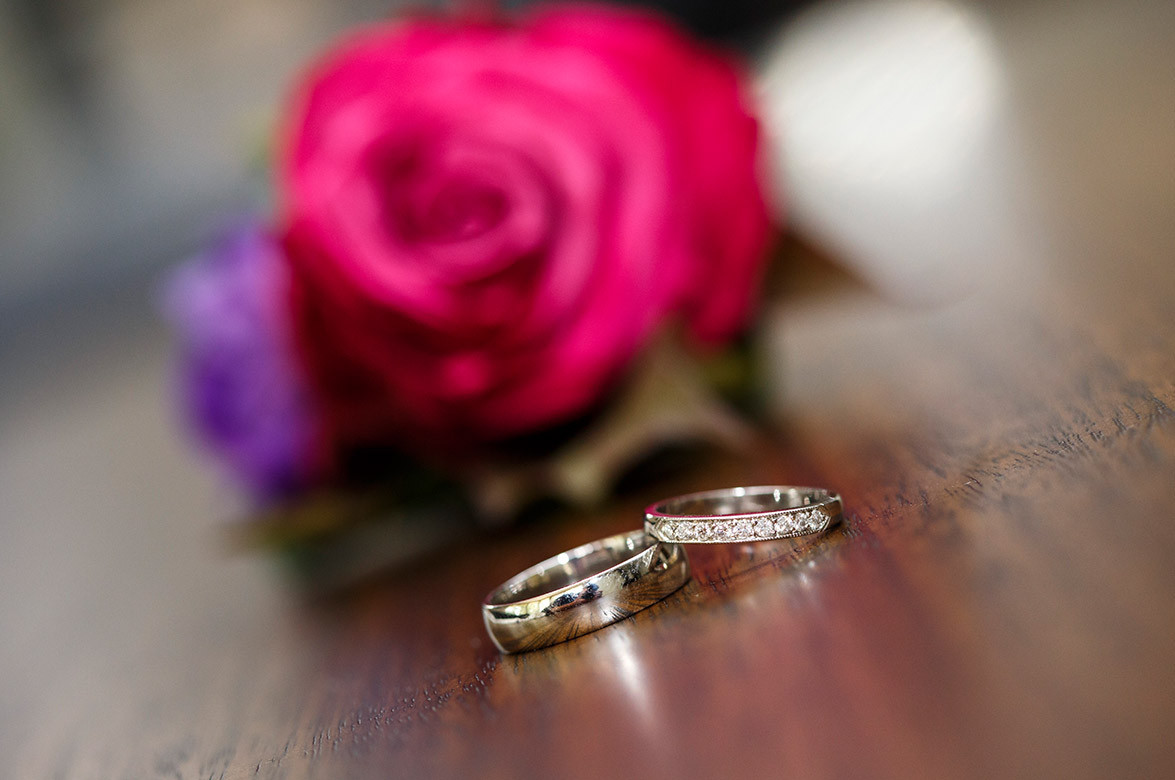 Groom getting ready
Groom getting ready
According to dfphoto.net, having a systematic shot list is essential to ensure all bases are covered and nothing important is forgotten.
4. Bride Coverage (1 Hour – 1.5 Hours): Capturing Elegance and Joy
What are the key elements of capturing beautiful and memorable bride preparation photos?
Bride coverage is similar to groom coverage, focusing on capturing elegance and joy. Start with detail shots of the engagement ring, flowers, and shoes while the bride finishes her hair and makeup. Utilize the master bedroom for its natural light and clean setting, closing the door to minimize distractions. Capture candid shots of the bride with her bridesmaids, individual and group portraits, and beautiful portraits of the bride near the window or on the bed. Include a “cheers” series with champagne in the lounge room and various family combinations. If time permits, use video lighting for additional portraits with a different mood.
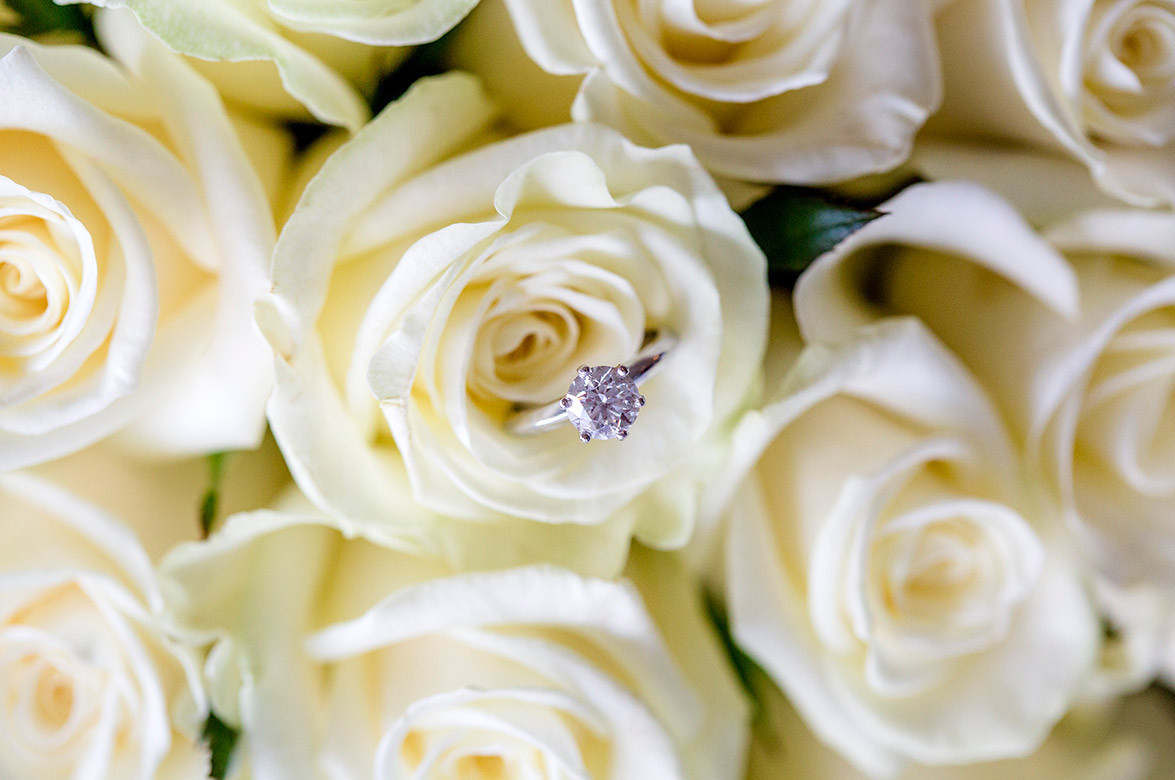 Bride getting ready with bridesmaids
Bride getting ready with bridesmaids
5. Ceremony: Capturing the Key Moments
What are the essential shots to capture during a wedding ceremony?
The ceremony is a pivotal part of the day, requiring you to capture key moments discreetly. Essential shots include the bride walking in and the groom’s reaction, a wide-angle shot of the venue, close-ups of the couple exchanging vows, the rings being placed on their fingers, parents shedding tears, the first kiss, the signing of the register, and the couple walking out through the crowd. According to dfphoto.net, being technically prepared for the challenges of dark and yellow lighting in churches is also vital.
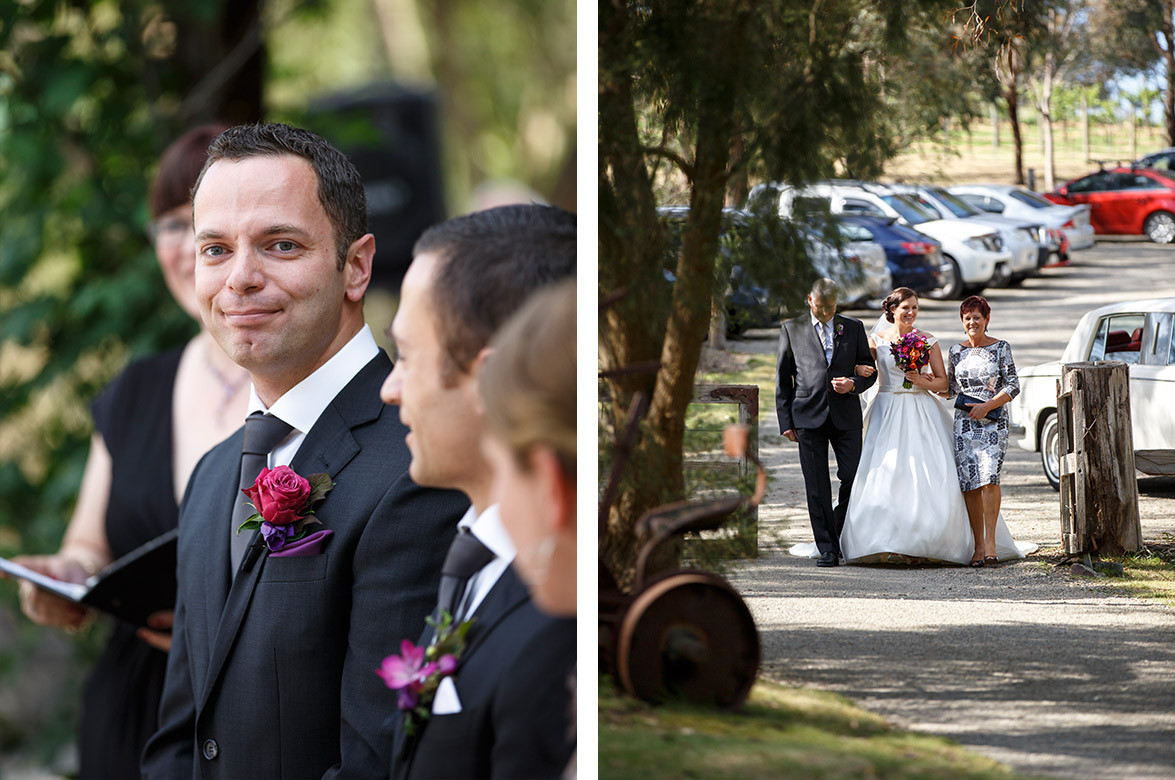 Bride and groom during ceremony
Bride and groom during ceremony
6. Congratulations, Group Photos & Family Photos: Organizing and Engaging
How can I effectively manage and capture the congratulations, group, and family photos while keeping everyone engaged?
After the ceremony, capture general wide-angle shots of the crowd congratulating the couple, as well as close-ups of the couple with their parents and siblings. Move around the crowd to capture candid shots of people in groups, which can drive traffic to your website as people look for their photos. Use a ladder for group shots, cracking jokes to keep everyone engaged. For family photos, announce the location and request immediate family members to gather there to streamline the process. Position the bride and groom with a pleasant background, being mindful of sunlight and shadows. Take multiple shots of each family combination to ensure everyone looks their best.
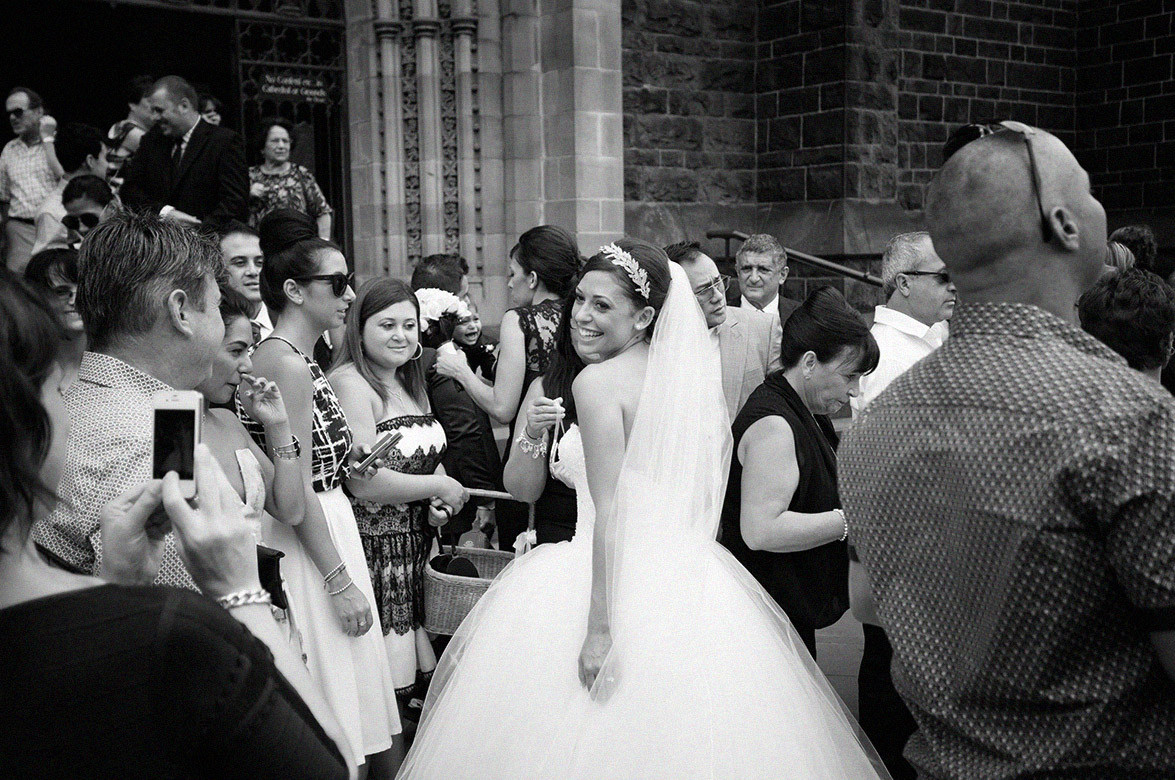 Wedding family photo
Wedding family photo
7. Locations: Creative and Efficient Photoshoots
What are the key considerations for location photoshoots to capture diverse and stunning images?
Location photoshoots are a creative challenge, requiring you to capture beautiful photos of the couple in diverse locations, using various compositions, and making the experience fun. Remember to keep track of time, travel to multiple locations, and be mindful of traffic, lighting, backdrops, parking, and random people in the background. Don’t forget to capture photos of the bridal party and their transport. According to dfphoto.net, you should aim to get images worthy of wall art.
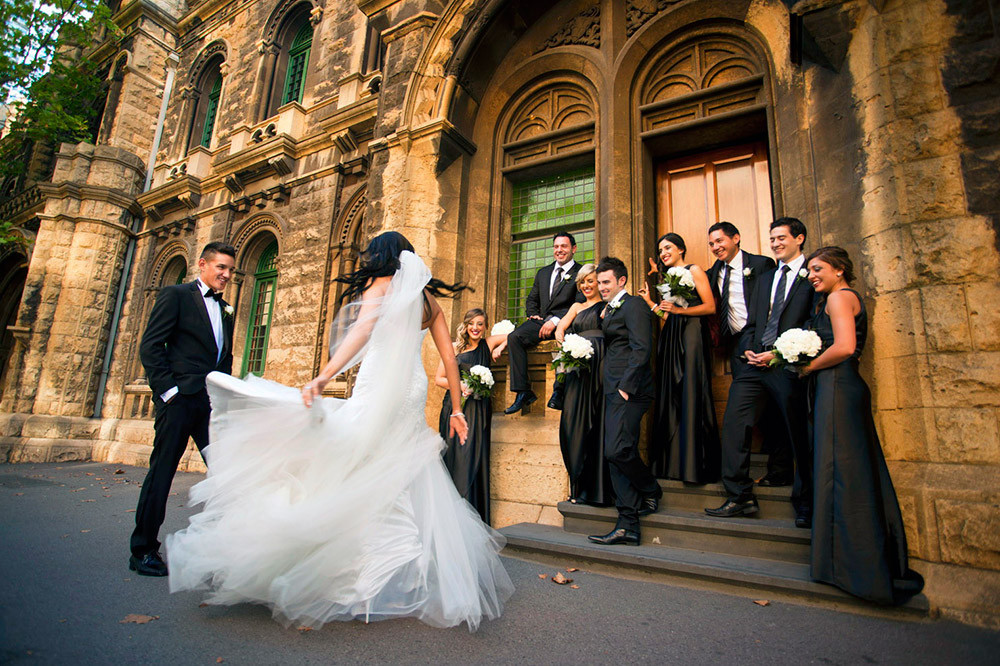 Bride and groom at scenic location
Bride and groom at scenic location
8. Reception: Capturing the Atmosphere
How can I effectively capture the atmosphere and key moments of the wedding reception?
At the reception, capture the atmosphere and key moments, including shots of the guests, venue, cake, table settings, and place cards. Capture the bridal party and couple being announced, shots of them at their table, and the first dance. Conclude with wide-angle shots of the dance floor with the couple in the middle. According to professional wedding photographers at dfphoto.net, the moments up until the first dance are the most important to capture.
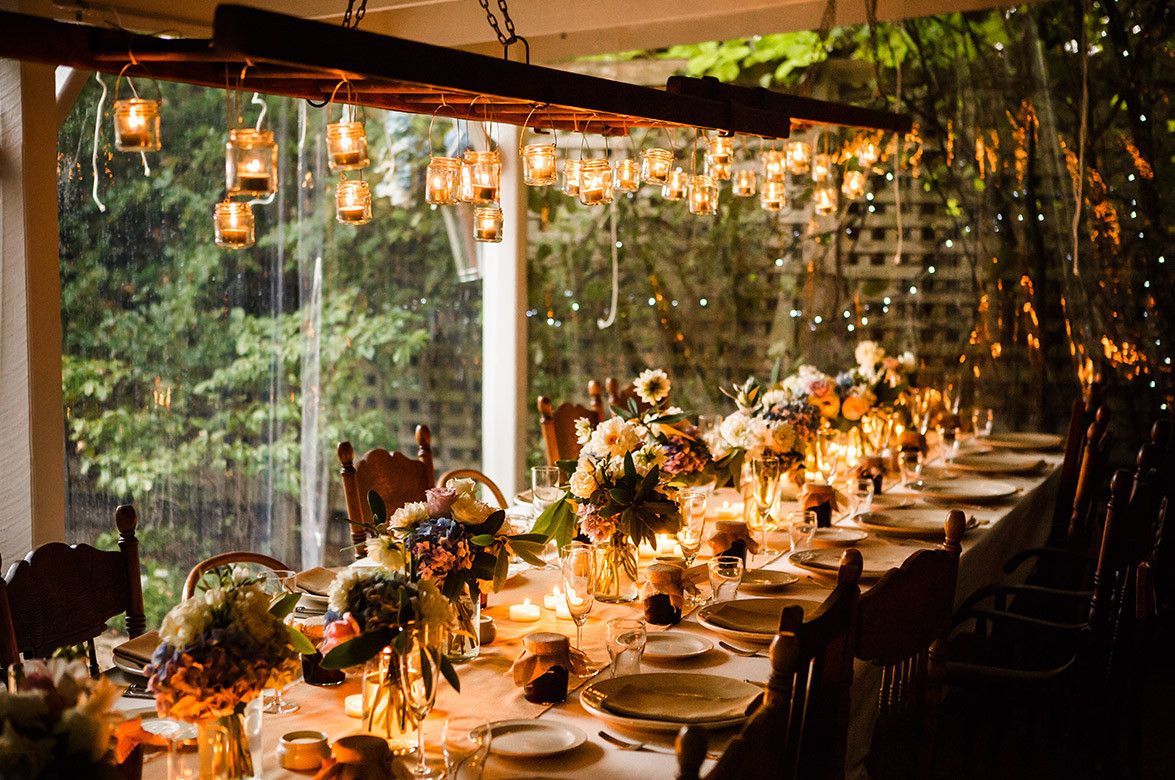 Wedding reception
Wedding reception
9. After the Wedding: Safeguarding Your Work
What is the most important task to complete immediately after a wedding shoot?
The most critical task after the wedding is to upload all the memory cards to your computer and check them before doing anything else. This ensures that your photos are safe and secure. If you are shooting again the next day, put everything on your hard drive, clear your cards, and prepare for the next event.
10. Essential Gear for Wedding Photography
What equipment is essential for capturing high-quality wedding photos, and how does each piece contribute to the final result?
Essential gear includes a professional-grade camera (or two for redundancy), a variety of lenses (wide-angle, standard, telephoto, and macro), speedlights or strobes for lighting, memory cards, extra batteries, and a reliable camera bag. Wide-angle lenses capture the scene, while telephoto lenses are great for candid shots and portraits. According to dfphoto.net, having backup equipment is critical for any wedding photographer.
Here’s a table summarizing essential equipment:
| Equipment | Purpose |
|---|---|
| Camera | Capturing images; having two allows for quick switching and redundancy. |
| Lenses | Wide-angle for scenes, telephoto for candids, standard for general use, macro for details. |
| Speedlights/Strobes | Providing additional light; crucial in low-light environments. |
| Memory Cards | Storing captured images; high-capacity cards are essential for long shoots. |
| Extra Batteries | Ensuring uninterrupted shooting; carry multiple fully charged batteries. |
| Camera Bag | Protecting and organizing equipment; choose a bag that is comfortable and functional. |
11. Mastering Camera Settings for Wedding Photography
What are the optimal camera settings for various wedding scenarios, and how do these settings impact the final image?
Mastering camera settings involves adjusting aperture, shutter speed, ISO, white balance, and focus modes based on the specific shooting conditions. For example, shooting in low light requires a wider aperture (e.g., f/2.8) and higher ISO (e.g., 3200), while outdoor portraits in bright sunlight might need a smaller aperture (e.g., f/5.6) and lower ISO (e.g., 100). Adjusting white balance ensures accurate colors, and selecting the appropriate focus mode (single, continuous, or manual) guarantees sharp images. According to insights from photography workshops, practicing these settings in various conditions is crucial for consistent results.
Here’s a table summarizing optimal camera settings:
| Scenario | Aperture | Shutter Speed | ISO | White Balance | Focus Mode |
|---|---|---|---|---|---|
| Low Light | f/2.8 | 1/60 | 3200 | Auto | Single |
| Outdoor Portraits | f/5.6 | 1/200 | 100 | Daylight | Single |
| Fast-Moving Subjects | f/4 | 1/500 | 400 | Auto | Continuous |
12. Posing Techniques for Wedding Photography
What posing techniques can help create flattering and natural-looking wedding photos?
Posing techniques include guiding the couple into natural and flattering positions, paying attention to their posture, weight distribution, and hand placement. Encourage interaction between the couple to create genuine emotions. Use angles and perspectives to enhance their features, and be mindful of the background to avoid distractions. According to dfphoto.net, practicing posing techniques with different body types and personalities is essential for a wedding photographer.
Here’s a list of basic posing tips:
- Posture: Encourage good posture with shoulders back and chin slightly forward.
- Weight Distribution: Shift weight to one leg for a more relaxed look.
- Hand Placement: Avoid flat or awkward hand positions; suggest holding hands or touching gently.
- Interaction: Encourage talking, laughing, or looking at each other for genuine emotions.
- Angles: Use angles to create a slimming effect or highlight features.
13. Lighting Techniques for Wedding Photography
What lighting techniques can enhance wedding photos, regardless of the environment?
Lighting techniques involve using natural light, artificial light, and reflectors to enhance wedding photos. When using natural light, position the subjects to take advantage of soft, diffused light and avoid harsh shadows. Artificial light, such as speedlights or strobes, can fill shadows and add dimension. Reflectors bounce light onto the subjects, creating a more even illumination. According to dfphoto.net, mastering lighting techniques is essential for wedding photographers.
Here’s a table summarizing lighting techniques:
| Technique | Description |
|---|---|
| Natural Light | Position subjects to take advantage of soft, diffused light and avoid harsh shadows. |
| Artificial | Use speedlights or strobes to fill shadows and add dimension. |
| Reflectors | Bounce light onto the subjects, creating a more even illumination. |
14. Editing Wedding Photos: Creating a Consistent Style
How do I edit wedding photos to achieve a consistent style and enhance their visual appeal?
Editing wedding photos involves using software like Adobe Lightroom or Photoshop to adjust exposure, contrast, white balance, colors, and sharpness. Develop a consistent editing style that reflects the couple’s preferences and enhances the mood of the photos. Use presets or actions to streamline the editing process while maintaining consistency across the entire collection. According to dfphoto.net, it’s crucial to preserve the natural look of the photos.
Here’s a list of essential editing steps:
- Exposure: Adjust overall brightness.
- Contrast: Enhance the difference between light and dark areas.
- White Balance: Correct color temperature for accurate colors.
- Colors: Adjust vibrance, saturation, and hue.
- Sharpness: Enhance detail.
15. Storytelling Through Wedding Photography
How can I tell a compelling story through wedding photos, capturing the emotions and events of the day?
Telling a story through wedding photos involves capturing key moments, candid interactions, and emotional expressions that convey the essence of the day. Start with photos of the preparation, continue with the ceremony, and conclude with the reception, capturing every important event in between. Arrange the photos in a chronological order that tells a coherent narrative. According to experienced wedding photographers, it’s essential to focus on the emotions and relationships between the people involved.
Here’s a list of tips for storytelling:
- Capture Key Moments: Focus on the most important events.
- Candid Interactions: Capture natural interactions between people.
- Emotional Expressions: Highlight emotional expressions.
- Chronological Order: Arrange photos to tell a coherent narrative.
16. Wedding Photography Trends in the USA
What are the current trends in wedding photography in the USA, and how can photographers incorporate them into their work?
Current trends in wedding photography in the USA include documentary-style photography, candid shots, drone photography, and the use of vintage lenses. Documentary-style photography focuses on capturing the events of the day as they unfold, while candid shots highlight natural interactions and emotions. Drone photography provides unique aerial perspectives, and vintage lenses add a nostalgic feel. According to dfphoto.net, it’s essential to stay up-to-date with the latest trends to offer modern and appealing services.
Here’s a table summarizing current trends:
| Trend | Description |
|---|---|
| Documentary Style | Capturing events as they unfold. |
| Candid Shots | Highlighting natural interactions and emotions. |
| Drone Photography | Providing unique aerial perspectives. |
| Vintage Lenses | Adding a nostalgic feel. |
17. Building a Wedding Photography Portfolio
What are the key elements of a compelling wedding photography portfolio, and how can photographers showcase their best work?
A compelling wedding photography portfolio should showcase your best work, reflecting your style, skills, and versatility. Include a variety of photos, such as portraits, candids, details, and venue shots. Organize your portfolio in a way that tells a story, highlighting the best moments from each wedding. According to professional portfolio consultants, it’s essential to present a consistent and cohesive collection of images.
Here’s a list of tips for building a portfolio:
- Showcase Best Work: Include only your strongest images.
- Reflect Style: Highlight your unique style and skills.
- Variety: Include a variety of photos.
- Tell a Story: Organize photos to tell a coherent narrative.
18. Marketing Your Wedding Photography Business
How can I effectively market my wedding photography business to attract clients and book more weddings?
Marketing your wedding photography business involves creating a strong online presence, networking with other vendors, and offering exceptional customer service. Create a professional website and social media profiles to showcase your work and attract potential clients. Network with wedding planners, venues, and other vendors to build relationships and generate referrals. Offer exceptional customer service to create satisfied clients who will recommend your services. According to dfphoto.net, marketing is essential for a successful wedding photography business.
Here’s a table summarizing marketing strategies:
| Strategy | Description |
|---|---|
| Online Presence | Create a professional website and social media profiles. |
| Networking | Build relationships with wedding planners, venues, and other vendors. |
| Customer Service | Offer exceptional customer service to create satisfied clients. |
19. Pricing Your Wedding Photography Services
How should I price my wedding photography services to ensure profitability and attract clients?
Pricing your wedding photography services involves considering your costs, experience, and market rates. Calculate your expenses, including equipment, travel, and editing time. Consider your experience and the value you bring to the clients. Research market rates in your area to ensure your prices are competitive. According to financial advisors, it’s essential to price your services to ensure profitability.
Here’s a list of factors to consider:
- Costs: Calculate your expenses.
- Experience: Consider your experience and value.
- Market Rates: Research market rates in your area.
20. Contracts and Legal Considerations for Wedding Photographers
What contracts and legal considerations are essential for protecting your wedding photography business?
Contracts and legal considerations include having a clear and comprehensive contract that outlines the services, payment terms, and cancellation policy. Obtain model releases from the couple to use their images for promotional purposes. Protect your copyright by registering your images and including a copyright notice on your website. According to legal experts, it’s essential to have these documents to protect your business.
Here’s a table summarizing essential documents:
| Document | Purpose |
|---|---|
| Contract | Outlines services, payment terms, and cancellation policy. |
| Model Release | Allows you to use the couple’s images for promotional purposes. |
| Copyright Notice | Protects your copyright and prevents unauthorized use of your images. |
21. Continuing Education and Resources for Wedding Photographers
What continuing education and resources are available for wedding photographers to enhance their skills and knowledge?
Continuing education and resources include attending workshops, conferences, and online courses. Read books, articles, and blog posts to stay up-to-date with the latest trends and techniques. Join photography communities and forums to network with other photographers and share knowledge. According to dfphoto.net, continuous learning is essential for a successful wedding photography career.
Here’s a list of resources:
- Workshops: Attend workshops to learn new skills.
- Conferences: Network with other photographers.
- Online Courses: Stay up-to-date with the latest techniques.
- Photography Communities: Share knowledge and experiences.
22. The Importance of Backups and Redundancy
Why is it essential to have backup plans and redundant systems in place during a wedding shoot?
Having backup plans and redundant systems is crucial to mitigate risks and ensure a smooth wedding shoot. Carry backup equipment, such as a second camera, extra lenses, and additional memory cards. Use dual card slots in your camera to create simultaneous backups of your images. Store your photos in multiple locations, such as external hard drives and cloud storage. According to dfphoto.net, redundancy is essential for any professional wedding photographer.
Here’s a table summarizing backup strategies:
| Strategy | Description |
|---|---|
| Backup Equipment | Carry a second camera, extra lenses, and additional memory cards. |
| Dual Card Slots | Use dual card slots in your camera to create simultaneous backups. |
| Multiple Locations | Store your photos in multiple locations, such as external hard drives and cloud storage. |
23. Managing Stress and Maintaining Professionalism
How can wedding photographers manage stress and maintain professionalism during a high-pressure wedding shoot?
Managing stress and maintaining professionalism involves planning, preparation, and self-care. Create a detailed timeline, communicate effectively with the couple and vendors, and anticipate potential problems. Take breaks, stay hydrated, and eat regularly to maintain your energy levels. Remain calm and professional, even when things don’t go as planned. According to experienced wedding photographers, it’s essential to prioritize self-care to perform at your best.
Here’s a list of stress management tips:
- Plan and Prepare: Create a detailed timeline and anticipate potential problems.
- Communicate Effectively: Stay in touch with the couple and vendors.
- Take Breaks: Rest and recharge.
- Stay Hydrated: Drink plenty of water.
- Eat Regularly: Maintain your energy levels.
24. Building Relationships with Vendors
Why is it important for wedding photographers to build strong relationships with other vendors, such as wedding planners and venues?
Building strong relationships with other vendors can generate referrals, improve collaboration, and enhance your reputation in the industry. Attend industry events, network with vendors, and offer mutual support. According to dfphoto.net, good relationships with vendors are essential for success.
Here’s a list of benefits:
- Referrals: Vendors can recommend your services.
- Collaboration: Working together can improve the overall experience for the couple.
- Reputation: A good reputation can attract more clients.
25. Essential Post-Wedding Tasks
What post-wedding tasks are essential for ensuring client satisfaction and maintaining a professional reputation?
Essential post-wedding tasks include editing the photos, delivering them to the couple, and requesting feedback. Edit the photos promptly and deliver them within the agreed-upon timeframe. Present the photos in a professional and appealing manner. Request feedback from the couple to improve your services. According to dfphoto.net, following through with these tasks demonstrates professionalism.
Here’s a table summarizing post-wedding tasks:
| Task | Description |
|---|---|
| Editing | Edit the photos to enhance their visual appeal. |
| Delivery | Deliver the photos to the couple within the agreed-upon timeframe. |
| Presentation | Present the photos in a professional and appealing manner. |
| Feedback | Request feedback from the couple to improve your services. |
26. The Role of Technology in Modern Wedding Photography
How is technology shaping the future of wedding photography, and what tools and innovations should photographers embrace?
Technology is transforming wedding photography, with advancements in camera technology, editing software, and online platforms. Photographers should embrace high-resolution cameras, AI-powered editing tools, and cloud-based storage and delivery systems. Drone photography, 360-degree photos, and virtual reality tours are also becoming increasingly popular. According to dfphoto.net, embracing technology is essential for staying competitive.
Here’s a list of technologies:
- High-Resolution Cameras: Capture more detail.
- AI-Powered Editing Tools: Streamline the editing process.
- Cloud-Based Systems: Improve storage and delivery.
- Drone Photography: Provide unique aerial perspectives.
27. Overcoming Common Challenges in Wedding Photography
What are some common challenges wedding photographers face, and how can they be overcome?
Common challenges include low-light conditions, difficult clients, and equipment malfunctions. Overcome low-light conditions by using artificial lighting and high ISO settings. Address difficult clients by communicating effectively and setting clear expectations. Prevent equipment malfunctions by maintaining your gear and carrying backup equipment. According to experienced wedding photographers, it’s essential to be prepared for these challenges.
Here’s a table summarizing challenges and solutions:
| Challenge | Solution |
|---|---|
| Low Light | Use artificial lighting and high ISO settings. |
| Difficult Clients | Communicate effectively and set clear expectations. |
| Equipment Malfunction | Maintain your gear and carry backup equipment. |
28. Ethics and Professional Conduct in Wedding Photography
What ethical considerations and professional conduct guidelines should wedding photographers adhere to?
Ethical considerations include respecting the couple’s privacy, obtaining their consent before using their images, and adhering to copyright laws. Professional conduct guidelines include being punctual, dressing appropriately, and communicating respectfully with the couple and vendors. According to dfphoto.net, ethical conduct is essential for maintaining trust.
Here’s a list of guidelines:
- Respect Privacy: Avoid sharing sensitive information.
- Obtain Consent: Get permission before using images.
- Adhere to Copyright Laws: Respect intellectual property.
- Be Punctual: Arrive on time for appointments.
29. Creating a Memorable Experience for the Couple
How can wedding photographers create a memorable and enjoyable experience for the couple?
Creating a memorable experience involves being friendly, professional, and attentive to the couple’s needs. Communicate effectively, listen to their preferences, and be flexible. Offer additional services, such as creating photo albums or slideshows. According to dfphoto.net, the goal is to exceed their expectations.
Here’s a list of tips:
- Be Friendly: Create a positive atmosphere.
- Communicate Effectively: Stay in touch with the couple.
- Listen to Preferences: Pay attention to their needs.
- Offer Additional Services: Provide extra value.
30. The Future of Wedding Photography
What trends and innovations are expected to shape the future of wedding photography, and how can photographers prepare for these changes?
The future of wedding photography will likely be shaped by AI, virtual reality, and personalized experiences. AI will automate editing tasks, while virtual reality will allow couples to relive their wedding day. Personalized experiences will involve creating custom packages and services tailored to each couple’s needs. According to industry experts, photographers should embrace these changes to remain competitive.
Here’s a table summarizing future trends:
| Trend | Description |
|---|---|
| AI | Automating editing tasks and improving image quality. |
| Virtual Reality | Allowing couples to relive their wedding day. |
| Personalized Experiences | Creating custom packages and services tailored to each couple’s needs. |
31. The Importance of Location Scouting
How can location scouting improve your wedding photography results?
Location scouting can help improve your wedding photography by identifying the best spots for photos, understanding the lighting at different times of the day, and planning your shots in advance. Scouting ensures that you’re prepared and can work efficiently on the wedding day. According to landscape photographers, knowing your location is critical.
Here’s a list of benefits:
- Identify Best Spots: Find scenic backgrounds.
- Understand Lighting: Plan for optimal lighting conditions.
- Plan Shots: Know what shots to take and where.
32. Mastering the Art of Black and White Wedding Photography
What techniques can help you master the art of black and white wedding photography?
Mastering black and white wedding photography involves understanding contrast, tonality, and composition. Focus on capturing strong emotions and timeless moments. According to dfphoto.net, black and white photography can create classic and elegant images.
Here’s a list of tips:
- Understand Contrast: Use contrast to create dramatic effects.
- Focus on Emotions: Capture strong emotions and moments.
- Timeless Moments: Create classic and elegant images.
33. How to Handle Unexpected Weather Conditions
What strategies can you use to handle unexpected weather conditions during a wedding shoot?
Handling unexpected weather involves being flexible, having backup plans, and using your gear to protect your equipment. If it rains, use umbrellas, find covered locations, or embrace the weather for unique shots. According to weather experts, being prepared is key.
Here’s a table summarizing strategies:
| Condition | Strategy |
|---|---|
| Rain | Use umbrellas, find covered locations, get creative. |
| Sun | Use reflectors, find shade, shoot during golden hour. |
| Wind | Secure equipment, use wind to create dynamic shots. |
34. The Art of Candid Wedding Photography
What techniques can help you capture authentic and candid moments during a wedding?
Capturing authentic and candid moments involves being unobtrusive, observing interactions, and anticipating key moments. Blend into the background, use a zoom lens, and be ready to capture spontaneous expressions. According to dfphoto.net, candid photography is about capturing genuine emotions.
Here’s a list of tips:
- Be Unobtrusive: Blend into the background.
- Observe Interactions: Watch for genuine moments.
- Anticipate Moments: Be ready to capture key expressions.
35. Creating a Workflow for Efficient Wedding Photography
How can you create a workflow for efficient wedding photography, from pre-wedding planning to post-processing?
Creating an efficient workflow involves planning, organization, and automation. Use project management software to track tasks, create templates for editing, and automate repetitive processes. According to productivity experts, a streamlined workflow can save time and improve results.
Here’s a table summarizing workflow stages:
| Stage | Tasks |
|---|---|
| Pre-Wedding | Planning, contracts, location scouting. |
| Wedding Day | Shooting, managing time, capturing key moments. |
| Post-Processing | Editing, delivering photos, requesting feedback. |
36. Wedding Photography Styles
What are the popular wedding photography styles, and how do they differ?
Popular wedding photography styles include traditional, photojournalistic, fine art, and modern. Traditional focuses on posed shots, photojournalistic captures candid moments, fine art emphasizes artistic expression, and modern combines elements of all styles. According to style experts, choosing the right style depends on the couple’s preferences.
Here’s a list of styles:
- Traditional: Posed shots and classic compositions.
- Photojournalistic: Candid moments and natural interactions.
- Fine Art: Artistic expression and creative techniques.
- Modern: Combination of styles to create unique images.
37. How To Get Started in Wedding Photography
What are the steps to becoming a professional wedding photographer?
Becoming a professional wedding photographer involves building skills, creating a portfolio, and launching your business. Start by learning photography techniques, then gain experience by shooting weddings for friends and family. Next, create a portfolio showcasing your best work, and finally, launch your business by creating a website and marketing your services. According to dfphoto.net, passion is key.
Here’s a list of steps:
- Learn Photography Techniques: Master basic skills.
- Gain Experience: Shoot weddings for friends and family.
- Create a Portfolio: Showcase your best work.
- Launch Your Business: Create a website and market your services.
38. Insurance for Wedding Photographers
What types of insurance do wedding photographers need?
Wedding photographers need liability insurance to protect against accidents, equipment insurance to cover damage or theft, and business interruption insurance to compensate for lost income. Insurance experts note that wedding photography comes with inherit risks, so insurance is recommended.
Here’s a table summarizing insurance types:
| Insurance | Coverage |
|---|---|
| Liability | Protects against accidents and injuries. |
| Equipment | Covers damage or theft of equipment. |
| Business Interruption | Compensates for lost income due to unforeseen circumstances. |
Frequently Asked Questions (FAQ)
1. What is the most important thing to capture at a wedding?
Capturing the emotions and genuine moments between the couple is the most important aspect, as these are the memories they will cherish forever.
2. What camera settings should I use for indoor wedding photography?
Use a wide aperture (f/2.8 or wider), a higher ISO (3200 or higher), and a shutter speed fast enough to avoid motion blur (1/60th of a second or faster).
3. How do I deal with harsh sunlight during outdoor wedding photos?
Find shade, use a reflector to bounce light, or shoot during the golden hours (early morning or late afternoon) when the light is softer.
4. What lenses are essential for wedding photography?
A versatile zoom lens (24-70mm), a wide-angle lens (16-35mm), and a telephoto lens (70-200mm) are essential for covering various shots and situations.
5. How do I pose a wedding couple who are not comfortable in front of the camera?
Offer gentle guidance, encourage natural interactions, and provide positive feedback to help them relax and feel more confident.
6. What is the best way to capture candid moments at a wedding?
Blend into the background, observe interactions, and be ready to capture spontaneous expressions without being intrusive.
7. How should I back up my wedding photos during and after the event?
Use dual card slots in your camera to create simultaneous backups, and store your photos on multiple external hard drives and cloud storage.
8. What software is best for editing wedding photos?
Adobe Lightroom and Photoshop are industry-standard software for editing wedding photos, offering a wide range of tools for adjusting exposure, color, and detail.
9. How do I create a consistent editing style for wedding photos?
Develop a set of presets or actions in Lightroom or Photoshop and apply them consistently across all your wedding photos to create a cohesive look.
10. What is the key to building a successful wedding photography business?
Building strong relationships with clients and vendors, delivering exceptional service, and continuously improving your skills and knowledge are key to success.
We hope this guide has provided you with valuable insights into How To Take Wedding Photos. For more in-depth tutorials, stunning image collections, and a thriving photography community, visit dfphoto.net. Elevate your photography skills and capture unforgettable moments! You can also visit us at 1600 St Michael’s Dr, Santa Fe, NM 87505, United States or call +1 (505) 471-6001.